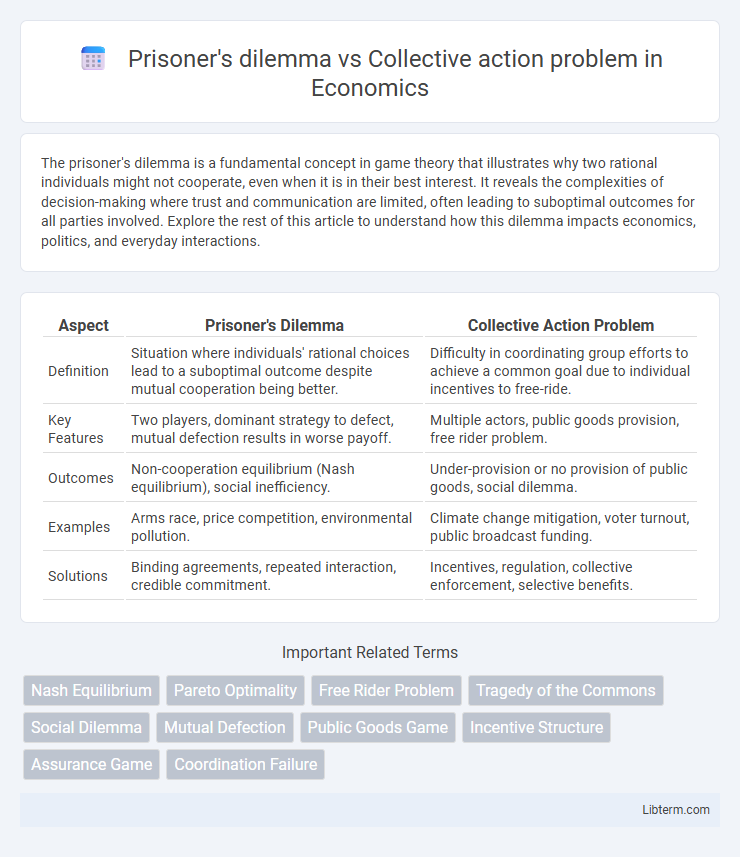The prisoner's dilemma is a fundamental concept in game theory that illustrates why two rational individuals might not cooperate, even when it is in their best interest. It reveals the complexities of decision-making where trust and communication are limited, often leading to suboptimal outcomes for all parties involved. Explore the rest of this article to understand how this dilemma impacts economics, politics, and everyday interactions.
Table of Comparison
| Aspect | Prisoner's Dilemma | Collective Action Problem |
|---|---|---|
| Definition | Situation where individuals' rational choices lead to a suboptimal outcome despite mutual cooperation being better. | Difficulty in coordinating group efforts to achieve a common goal due to individual incentives to free-ride. |
| Key Features | Two players, dominant strategy to defect, mutual defection results in worse payoff. | Multiple actors, public goods provision, free rider problem. |
| Outcomes | Non-cooperation equilibrium (Nash equilibrium), social inefficiency. | Under-provision or no provision of public goods, social dilemma. |
| Examples | Arms race, price competition, environmental pollution. | Climate change mitigation, voter turnout, public broadcast funding. |
| Solutions | Binding agreements, repeated interaction, credible commitment. | Incentives, regulation, collective enforcement, selective benefits. |
Understanding the Prisoner's Dilemma
The Prisoner's Dilemma illustrates a situation where two individuals acting in their own self-interest fail to achieve the optimal collective outcome, revealing inherent challenges in cooperative behavior. This dilemma highlights the conflict between individual rationality and group benefit, as each prisoner chooses betrayal despite mutual cooperation yielding a better result. Understanding this game theory model provides key insights into issues like public goods provision, environmental agreements, and collective action problems.
Defining the Collective Action Problem
The Collective Action Problem occurs when individuals face incentives to prioritize personal interests over group benefits, resulting in suboptimal outcomes for the entire group. Unlike the Prisoner's Dilemma, which involves strategic decision-making between two players with conflicting choices, the Collective Action Problem often involves larger groups where coordination and cooperation are challenging. Public goods provision and free-rider issues are central examples illustrating the difficulties in achieving collective benefits despite shared interests.
Key Differences: Prisoner's Dilemma vs Collective Action Problem
The Prisoner's Dilemma centers on two individuals facing a choice to cooperate or defect, with the dominant strategy leading to mutual defection despite it being suboptimal. In contrast, the Collective Action Problem involves larger groups where individuals benefit from a public good without contributing, resulting in free-rider issues. Key differences include the scale of participants and the type of strategic interaction: the Prisoner's Dilemma features pairwise interactions with clear payoffs, while Collective Action Problems involve multiple actors and challenges in mobilizing cooperation for shared benefits.
Game Theory Foundations and Assumptions
The Prisoner's Dilemma and Collective Action Problem both arise from game theory foundations that analyze strategic decision-making among rational players. The Prisoner's Dilemma assumes two players whose optimal individual strategies lead to a suboptimal collective outcome, highlighting the conflict between personal incentive and mutual benefit. The Collective Action Problem extends this framework to multiple players, emphasizing how individuals' unwillingness to contribute to a public good despite collective gains causes cooperation failure.
Real-world Examples of the Prisoner's Dilemma
The Prisoner's Dilemma illustrates scenarios where individuals face incentives to defect despite collective benefits from cooperation, evident in arms races between nations and competitive business practices like price undercutting. In the Cold War, the mutual distrust between the U.S. and Soviet Union led to nuclear buildup, exemplifying the dilemma's impact on global security dynamics. Corporate competition often results in reduced profits industry-wide as companies engage in aggressive pricing strategies, highlighting the challenge of sustaining cooperation without enforceable agreements.
Real-world Examples of Collective Action Problems
Collective action problems arise in scenarios like climate change mitigation, where individual countries prioritize self-interest over global benefits, leading to underinvestment in emissions reduction. Overfishing in international waters exemplifies the dilemma as fishermen race to catch fish, depleting stocks despite long-term harm. Public goods provision, such as funding public broadcasting, faces challenges as individuals may free-ride, benefiting without contributing to the cost.
Role of Cooperation and Trust
In the Prisoner's Dilemma, cooperation is strategically fragile due to the incentive to defect, making trust essential yet difficult to establish among participants. The Collective Action Problem amplifies the challenge of mobilizing cooperation for public goods, where trust in others' contributions determines individual willingness to participate. Both scenarios highlight that sustained trust mechanisms significantly increase cooperative outcomes, mitigating the risks of free-riding and defection.
Strategies for Overcoming Both Dilemmas
Strategies for overcoming the Prisoner's Dilemma and Collective Action Problem include fostering trust through repeated interactions and establishing clear communication channels among participants. Incentive structures such as rewards for cooperation or penalties for defection motivate individuals to prioritize collective benefits over short-term self-interest. Implementing institutional mechanisms like contracts, monitoring systems, and enforcement policies ensures compliance and reduces free-riding in both dilemmas.
Impacts on Public Policy and Governance
The Prisoner's dilemma highlights the challenge of individual incentives conflicting with collective welfare, often leading to suboptimal outcomes in public policy such as underinvestment in public goods and regulatory non-compliance. Collective action problems emphasize the difficulties in mobilizing groups to achieve common goals, impacting governance by necessitating mechanisms like enforcement, incentives, and institutional design to encourage cooperation. Both frameworks shape policy strategies by informing approaches to coordination, trust-building, and balancing individual versus collective interests in resource management and social welfare programs.
Lessons for Future Collective Decision-Making
The Prisoner's Dilemma illustrates the challenge of individual rationality leading to suboptimal group outcomes, highlighting the need for trust and enforceable agreements in collective decision-making. The Collective Action Problem emphasizes the difficulty of motivating individuals to contribute to a common good without free-riding incentives, underscoring the importance of designing incentives and institutional mechanisms. Both concepts teach that future collective decisions require balancing individual interests with group benefits to achieve cooperation and sustainable solutions.
Prisoner's dilemma Infographic

 libterm.com
libterm.com